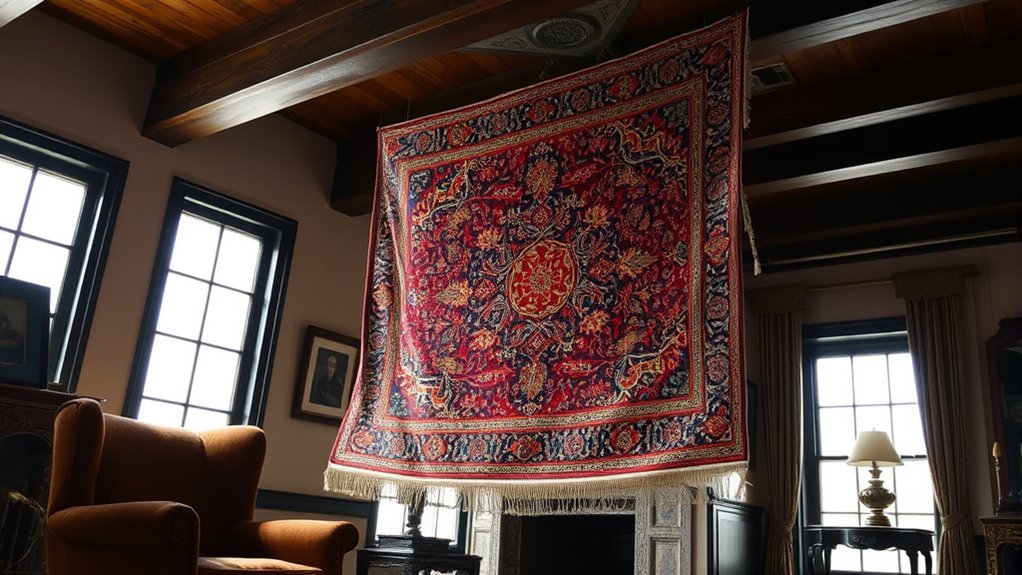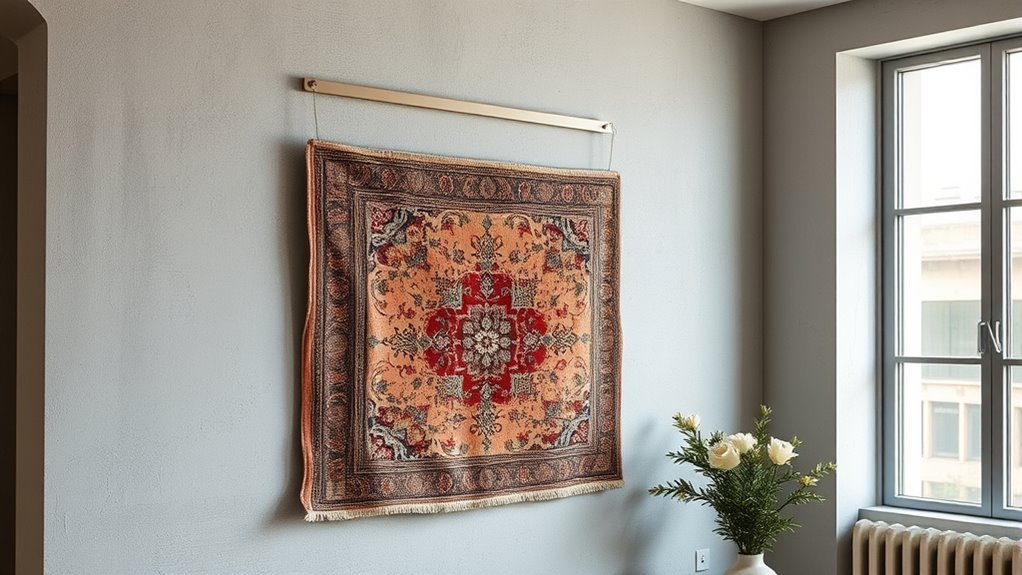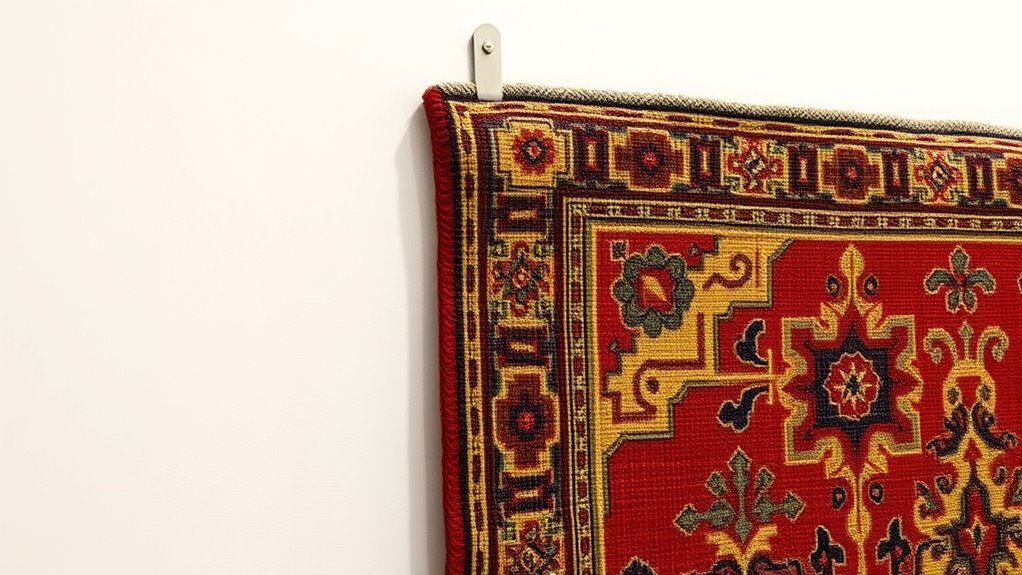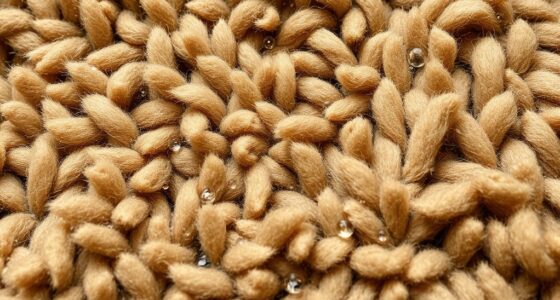To safely hang an antique rug as wall art, first evaluate its condition for tears or weak spots and choose a stable, low-light location away from humidity. Use sturdy, non-invasive hardware like rails or padded hooks to evenly distribute weight without damaging fibers. Prepare the rug by cleaning and supporting fragile areas, then mount it carefully with secure backing. For creative display ideas and expert tips, explore further to guarantee your rug hangs beautifully and safely.
Key Takeaways
- Choose sturdy, corrosion-resistant hardware and secure mounting points into wall studs or anchors rated for heavy textiles.
- Use framing or fabric sleeves to evenly distribute weight and prevent fiber stress or tears.
- Ensure the rug is clean, free of damage, and properly supported with backing or stabilizers before hanging.
- Avoid direct sunlight and high-traffic areas to preserve color and condition over time.
- Incorporate creative display techniques like custom framing or pairing with other art for a visually appealing presentation.
Assessing the Condition and Choosing the Right Location

Before hanging your antique rug, it’s essential to evaluate its condition carefully. Check for any tears, frays, or weak areas that might need professional repair before display. Once you’re confident in its integrity, consider the framing options that best support the rug’s preservation and aesthetic appeal. Proper framing can prevent further damage and enhance its visual impact. Lighting considerations are equally important; avoid direct sunlight, which can fade colors, and opt for soft, indirect lighting to showcase the rug’s details without causing harm. Choose a location that provides a stable environment—away from humidity, heat sources, and high traffic—to preserve its condition. Carefully selecting the right placement ensures your antique rug remains a stunning and well-preserved piece of art. Additionally, understanding self watering plant pots can inspire innovative ways to display or care for your textile art, ensuring long-term preservation.
Selecting Appropriate Hanging Methods and Hardware

Choosing the right hanging methods and hardware is crucial to safely display your antique rug without risking damage. Start by considering framing techniques that evenly distribute weight and prevent stress points, like a flat, secure mount or a specialized textile hanger. When selecting mounting hardware, opt for sturdy hooks or rails designed for heavy, textured materials. Use corrosion-resistant materials to avoid deterioration over time. Avoid nails or thin hooks that may cause tears or uneven tension. Instead, choose padded or smooth-edged hardware that minimizes abrasion. Ensure your hardware is rated for the weight of the rug, and install it securely into wall studs or anchors. Properly selected framing techniques and quality mounting hardware will preserve your antique rug’s integrity while showcasing its beauty safely. Additionally, understanding market dynamics and the evolving landscape of digital assets can inspire innovative presentation ideas that highlight the unique history and craftsmanship of antique textiles.
Preparing the Rug for Wall Display

To guarantee your antique rug hangs securely and maintains its condition, you need to carefully prepare it for wall display. Start by inspecting the rug for any damage or loose fibers, addressing minor issues before hanging. Gently clean the surface with a soft brush or vacuum to remove dust and dirt, which supports rug preservation. Consider applying a backing or stabilizer if the rug is fragile, preventing tears or stretching. Ensure the rug’s edges are straight and even, as this improves its appearance as wall decoration. Roll the rug loosely with the front facing outward, avoiding tight folds that could cause creases. Properly preparing your antique rug helps protect its integrity and enhances its visual appeal, making it a stunning and safe wall feature. Additionally, researching collectible decor trends can inspire ways to showcase your rug as a unique art piece.
Expert Tips for Secure and Safe Mounting

Proper mounting techniques are essential to guarantee your antique rug stays secure and undamaged over time. Use materials that won’t harm the dye preservation or compromise the rug’s integrity. Avoid nails or staples directly through the fibers; instead, opt for a sturdy, non-invasive hanging system like a rail or a secure fabric sleeve. When selecting mounting hardware, consider weight and size to prevent sagging or stress on delicate areas. If you’re restoring or conserving the rug, consult an antique restoration expert to ensure your mounting method doesn’t interfere with or damage historical fibers or dyes. Regularly check the mounting for signs of wear or deterioration, and adjust as needed. Properly secured, your antique rug will remain a stunning, safe display piece for years. Additionally, understanding the color accuracy of the display setup can help in maintaining the true visual appeal of your antique rug.
Creative Ideas for Showcasing Antique Rugs as Wall Art

Transforming your antique rug into striking wall art opens up endless creative possibilities that showcase its beauty and craftsmanship. To guarantee rug preservation, choose appropriate hanging methods that avoid damaging the fibers. Decorative framing is an excellent option, providing a polished look while protecting your rug from dust and light exposure. You can opt for a custom frame that complements your decor or a simple, sleek border to highlight intricate patterns. Consider mounting the rug on a sturdy backing or using a flat, secure hanging system that prevents sagging or distortion. Mixing textures and colors with other art pieces can create a dynamic display. Remember, your goal is to celebrate your antique rug’s history while maintaining its condition for years to come. Incorporating specialized hanging techniques can further ensure the longevity and safety of your treasured piece.
Frequently Asked Questions
How Can I Prevent Damage to Fragile Antique Rugs When Hanging?
To prevent damage when hanging fragile antique rugs, you need to be careful. Start by supporting the fringe preservation, as it’s often delicate; avoid pulling or stressing it. Use backing reinforcement if necessary, to provide extra stability without harming the rug’s fibers. Always choose gentle hanging methods like padded hooks or rods, and handle the rug carefully to maintain its integrity and prevent tears or deterioration over time.
What Are the Best Lighting Options to Highlight Antique Rug Wall Art?
Think of lighting as the spotlight on your masterpiece. You should use soft, focused lighting techniques to enhance your antique rug’s intricate details without causing damage. Position your spotlight placement carefully—aim for adjustable track lighting or LED gallery lights that prevent heat buildup. These choices cast a gentle glow, highlighting your rug’s beauty while preserving its delicate fibers. Proper lighting transforms your wall art into a mesmerizing focal point.
How Often Should I Inspect the Hanging Setup for Safety?
You should perform an inspection routine for your hanging setup at least once every three to six months. Safety checks are essential to make certain the hooks, wires, and mounting hardware remain secure and undamaged. Regularly inspecting prevents accidents and keeps your antique rug art safe. Pay close attention to any signs of wear or loosening, and promptly address any issues to maintain a secure display and protect your valuable piece.
Can I Hang Antique Rugs Outdoors or in Humid Environments?
You might wonder if you can hang antique rugs outdoors or in humid environments. While outdoor exposure offers a beautiful display, it risks damage from weather and humidity effects. High humidity can cause mold, mildew, and fiber deterioration, so it’s best to avoid placing antique rugs in such settings. If you want outdoor display, consider protective coverings and guarantee proper ventilation to minimize humidity effects and preserve your rug’s integrity.
What Are Eco-Friendly and Reversible Hanging Options for Antique Rugs?
You want eco-friendly, reversible hanging options for your antique rug. Consider using eco-friendly adhesives that don’t harm the environment and can be removed easily without damage. Reversible mounting methods, like tension rods or removable hooks, let you display your rug without permanent fixtures. These options protect your antique piece and are gentle on your walls, offering a sustainable, flexible way to showcase your rug as art.
Conclusion
So, now that you’re ready to elevate your antique rug from mere floor décor to gallery-worthy wall art, remember: safety first, style second (just kidding, style is king). Don’t hang it like a drunken pirate—use proper hardware, or your masterpiece might become modern art itself. With these tips, you’ll impress guests and avoid disaster. Who knew that hanging a rug could be so perilous—and so fashionable? Happy decorating!









